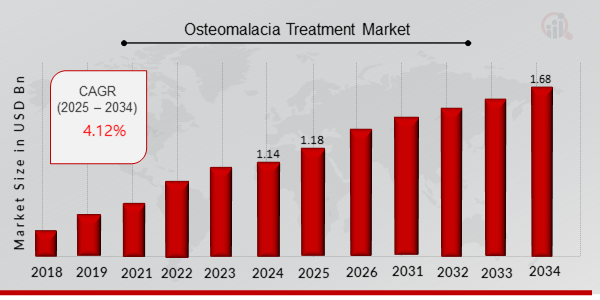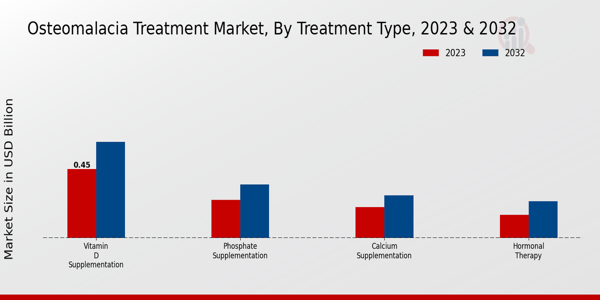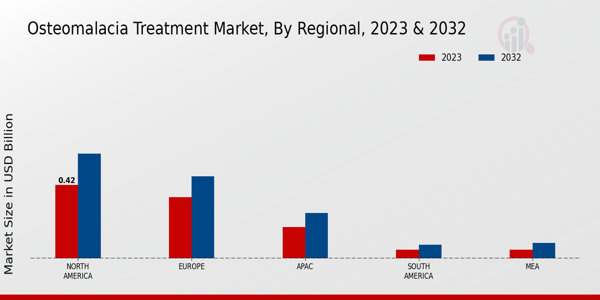Global Osteomalacia Treatment Market Overview
As per MRFR analysis, the Osteomalacia Treatment Market Size was estimated at 1.14 (USD Billion) in 2024. The Osteomalacia Treatment Market Industry is expected to grow from 1.18 (USD Billion) in 2025 to 1.68 (USD Billion) till 2034, at a CAGR (growth rate) is expected to be around 4.01% during the forecast period (2025 - 2034).
Key Osteomalacia Treatment Market Trends Highlighted
Several key drivers influence the Osteomalacia Treatment Market. An increasing prevalence of osteomalacia, often linked to vitamin D deficiency, has raised awareness among healthcare professionals and patients alike. Additionally, the growing aging population and the demand for effective treatments to combat bone disorders are fueling market growth. Advancements in research and technology also play a vital role, as new therapies and improved diagnostic tools enhance patient outcomes, making it essential for healthcare providers to adopt updated practices. Opportunities in the Osteomalacia Treatment Market are abundant.
With the rising focus on personalized medicine, there is potential for the development of tailored treatment approaches that cater to individual patient needs.Geographical growth in foreign markets is also useful because of the developing healthcare infrastructure as well as the growing patient awareness of bone health.
The combination of pharmaceutical firms with research institutions can result in the creation of new solutions for the treatment and, as a result – of expansion of the market. Integration of trends, which are at present becoming more pronounced, consists of the use of drugs in combination with modification of lifestyle, as well as nutritional advice. There is a growing focus on addressing the underlying factors responsible for osteomalacia rather than treating the disease only its effects. Emerging technologies in health, like telehealth and mobile health, are also coming closer to the patient, increasing patient empowerment and adherence monitoring.
In addition, it is expected that treatment cycles will be newer in the coming years, which has generated anticipation for clinical trials of such methods. These trends present a dynamic landscape for the various stakeholders in the Osteomalacia Treatment Market, requiring consistent evolution and creativity.

Source: Primary Research, Secondary Research, Market Research Future Database and Analyst Review
Osteomalacia Treatment Market Drivers
Increasing Prevalence of Osteomalacia
The increasing prevalence of osteomalacia and related bone disorders significantly drives the Osteomalacia Treatment Market Industry. As populations around the world age and as dietary deficiencies become more prevalent, especially with regard to vitamin D, the incidence of osteomalacia is expected to rise. Patients often present with bone pain, muscle weakness, and an increased risk of fractures, prompting a higher demand for effective treatments.The growing awareness of osteomalacia among healthcare providers and patients is leading to better diagnosis rates, which in turn supports the need for treatment options in the market.
Additionally, the increase in lifestyle-related factors such as sedentary behavior and poor nutrition translates to a higher risk of developing conditions that contribute to osteoporosis and osteomalacia. As public health campaigns increase awareness and provide education, the market is expected to expand further due to the focus on preventing and treating these conditions early.The development of more targeted therapies and solutions for these patients will also play a vital role in shaping the future landscape of the Osteomalacia Treatment Market Industry.
Advancements in Treatment Options
Advancements in treatment options significantly drive growth in the Osteomalacia Treatment Market Industry. Over recent years, there has been a notable increase in research and development of new therapies, ranging from pharmaceutical interventions to supplements aimed at addressing vitamin D deficiency. This continuous innovation allows for a greater number of effective solutions tailored to patients' specific needs, ultimately improving patient outcomes.Moreover, the emergence of personalized medicine approaches is revolutionizing the way osteomalacia is treated, ensuring that patients receive the most effective and appropriate treatment.
Such advancements not only attract the attention of healthcare professionals but also instill confidence in patients, thereby propelling market growth.
Supportive Government Initiatives
Supportive government initiatives and healthcare policies also play an instrumental role in the growth of the Osteomalacia Treatment Market Industry. Many governments are increasingly recognizing the importance of addressing bone health issues and have introduced programs aimed at improving the diagnosis and treatment of osteomalacia. These initiatives often include funding for research, awareness campaigns, and public health guidelines promoting the importance of vitamin D and calcium intake.By fostering an environment that prioritizes bone health, governments not only influence public behavior towards nutritional awareness but also stimulate the healthcare market by encouraging investments in treatment solutions.
Such proactive measures create a supportive platform for the development and distribution of osteomalacia treatment options, compelling further advancements and expanded reach in the market.
Osteomalacia Treatment Market Segment Insights
Osteomalacia Treatment Market Treatment Type Insights
In the Osteomalacia Treatment Market, the Treatment Type segment plays a critical role, with 2023 values showcasing the various forms of treatments available to patients. The total market for this segment stood at 1.05 USD Billion and is projected to grow significantly over the next decade. Within this segment, Vitamin D Supplementation emerges as the dominant force, valued at 0.45 USD Billion in 2023 and expected to reach 0.63 USD Billion by 2032, capturing a majority holding of the market.
It is crucial as Vitamin D plays a vital role in calcium metabolism and bone health, making its supplementation a primary focus for treating osteomalacia.Phosphate Supplementation also holds significant relevance, garnering a valuation of 0.25 USD Billion in 2023, with expectations to increase to 0.35 USD Billion by 2032. This segment is particularly important as phosphate is essential for bone remodeling and preventing further bone demineralization. On the other hand, Calcium Supplementation is valued at 0.20 USD Billion in 2023 and is projected to grow to 0.28 USD Billion by 2032.
The need for adequate calcium support complements the other treatment types, thus making it a fundamental aspect of osteomalacia management, albeit with a lesser share compared to Vitamin D and phosphate.Lastly, Hormonal Therapy, valued at 0.15 USD Billion in 2023 and expected to rise to 0.24 USD Billion by 2032, serves a more specialized role in the market by addressing hormonal imbalances that may contribute to osteomalacia. While it represents the smallest market share in the Treatment Type segment, its importance cannot be overlooked as it provides a necessary option for those whose osteomalacia is influenced by hormonal deficiencies.
Collectively, these segments showcase the complexity of treating osteomalacia, where each type addresses different aspects of the condition and complements one another to enhance patient health outcomes.With the Osteomalacia Treatment Market poised for growth, the interplay among these treatment types is expected to evolve, driven by advancements in medical research and increasing awareness of the condition. The insights derived from this market data reveal potential growth opportunities as healthcare systems continue to prioritize effective osteomalacia management strategies, further solidifying the significance of these treatment types in the overall market landscape.

Source: Primary Research, Secondary Research, Market Research Future Database and Analyst Review
Osteomalacia Treatment Market Route of Administration Insights
The Osteomalacia Treatment Market, valued at 1.05 USD Billion in 2023, showcases a diverse array of options under the Route of Administration segment. This market is crucial as it influences patient compliance and overall treatment efficacy. The segmentation includes Oral, Injectable, and Transdermal routes, each contributing uniquely to the treatment landscape. Oral administration is favored due to its convenience and ease of use, often enhancing patient adherence to treatment regimens. Injectable forms are significant as they provide faster therapeutic effects, especially in patients requiring immediate intervention.Transdermal delivery allows for continuous absorption of medication, attracting those who prefer non-invasive options.
The combination of these routes shapes the dynamics of the Osteomalacia Treatment Market, with each route reflecting distinct preferences and medical needs in treatment approaches. As the market continues to evolve, understanding these trends will be vital for stakeholders aiming to align with patient and healthcare practitioner preferences while navigating challenges such as formulation stability and delivery efficiency.The Osteomalacia Treatment Market data will further inform strategies as it aims to achieve a market value of 1.5 USD Billion by 2032, backed by a steady growth trajectory in the industry.
Osteomalacia Treatment Market Patient Demographic Insights
The Patient Demographic segment of the Osteomalacia Treatment Market reveals significant trends and growth potential, with the overall market valued at 1.05 billion USD in 2023. This segment is primarily categorized into Pediatric, Adult, and Geriatric groups, each playing a distinct role in the market dynamics.
The Pediatric demographic is essential as early diagnosis and treatment contribute to healthier growth and development, while the Adult population represents a considerable share due to lifestyle-related risk factors and conditions meeting their treatment needs.The Geriatric segment also dominates, given the increased prevalence of osteomalacia in the aging population, which often experiences deficiencies in vitamin D and calcium. This understanding of the Osteomalacia Treatment Market segmentation not only drives targeted healthcare solutions but also helps mitigate broader health complications emerging from untreated conditions.
Factors such as an increasing aging population, urban lifestyle changes, and rising awareness of bone health issues continue to boost market growth while challenges like underdiagnosis and healthcare access disparities persist.The Osteomalacia Treatment Market data suggests that tailoring treatment plans to these demographics will be vital as the industry evolves, fostering opportunities for innovation and improvement in patient care.
Osteomalacia Treatment Market Therapeutic Area Insights
The Osteomalacia Treatment Market in the Therapeutic Area segment achieved a market value of 1.05 billion USD in 2023. The market is expected to expand further, driven by increased awareness of osteomalacia and the need for effective treatments. Within this segment, various fields such as Endocrinology, Orthopedics, and General Medicine play crucial roles. Endocrinology is significant due to hormonal imbalances frequently associated with bone disorders like osteomalacia, making it a key area for innovative therapies.
Orthopedics dominates the treatment landscape as it focuses on managing bone health and mobility, which are essential for patient recovery.General Medicine also represents a vital sector as it integrates different therapeutic strategies and approaches for holistic patient care. Overall, the diverse applications within the Osteomalacia Treatment Market segmentation highlight the critical need for tailored treatment solutions as the market continues to evolve amidst changing patient demographics and healthcare requirements. The projected growth reflects a sustainable increase in market dynamics, propelled by ongoing research and development efforts aimed at enhancing osteomalacia therapies.
Osteomalacia Treatment Market Regional Insights
The Osteomalacia Treatment Market revenue was valued at approximately 1.05 USD Billion in 2023 and is projected to grow in various regions. North America holds a significant position in the market with a valuation of 0.42 USD Billion in 2023, forecasted to reach 0.6 USD Billion by 2032, indicating its majority holding and demand for Osteomalacia treatments driven by a well-established healthcare infrastructure.
Europe follows closely behind, valued at 0.35 USD Billion in 2023 and expected to grow to 0.47 USD Billion by 2032, benefiting from rising awareness and advanced treatment options.The APAC region, with a valuation of 0.18 USD Billion in 2023 and a projected increase to 0.26 USD Billion in 2032, is seeing growth due to increasing patient populations and improving healthcare access. South America and MEA are comparatively smaller markets, each valued at 0.05 USD Billion in 2023, with South America expected to rise to 0.08 USD Billion and MEA to 0.09 USD Billion by 2032.
These regions reflect emerging opportunities, albeit facing challenges like limited healthcare resources. The Osteomalacia Treatment Market segmentation illustrates varied growth trajectories, highlighting the need for tailored strategies to maximize market potential in specific regions.

Source: Primary Research, Secondary Research, Market Research Future Database and Analyst Review
Osteomalacia Treatment Market Key Players and Competitive Insights
The Osteomalacia Treatment Market is an evolving sector that has gained attention due to the increasing prevalence of bone disorders, particularly among the aging population. Various players in the market are focusing on developing effective therapies to address osteomalacia, which is characterized by the softening of bones, often due to vitamin D deficiency. With a growing awareness of the disease and its implications, treatment options and strategies are being explored and introduced by various companies.
The competitive landscape is shaped by pharmaceutical firms that leverage innovative research and development practices to bring new products to market, ensuring that they meet the evolving needs of patients and healthcare providers. As competition intensifies, companies are also focusing on strategic partnerships, collaborations, and expansions to enhance their market presence globally.Mylan has established a significant presence in the Osteomalacia Treatment Market, predominantly known for its commitment to providing high-quality generic pharmaceuticals. This approach allows Mylan to offer cost-effective treatment alternatives for osteomalacia, thereby increasing accessibility for patients who may otherwise struggle with the financial burden of branded medications.
The company's strengths lie in its robust manufacturing capabilities and a broad portfolio of products that address not only osteomalacia but also other related bone health issues. Mylan's strong distribution network and established relationships with healthcare providers enable effective market penetration, ensuring that their treatment options are readily available to patients in various regions. The focus on regulatory compliance and maintaining high standards in quality control further solidifies Mylan's reputation as a reliable entity in the treatment landscape.Amgen is another key player in the Osteomalacia Treatment Market, recognized for its pioneering role in biotechnology-based therapies.
The company is known for its innovative solutions that target specific pathways involved in bone metabolism, thereby providing advanced treatment options for patients suffering from osteomalacia. Amgen's strengths include a strong emphasis on research and development, which allows it to stay at the forefront of scientific advancements in treating bone disorders. Its established reputation in the biopharmaceutical industry enables Amgen to engage with healthcare professionals and institutions effectively, facilitating the acceptance and adoption of its treatment modalities.
Moreover, Amgen's commitment to patient education and outreach enhances its brand image, as it fosters a collaborative approach to treatment that emphasizes the importance of adherence to therapy regimens. As the market continues to evolve, Amgen's innovative offerings position it as a significant contributor to the treatment of osteomalacia and related conditions.
Key Companies in the Osteomalacia Treatment Market Include
- Regeneron Pharmaceuticals
Osteomalacia Treatment Market Industry Developments
Recent developments in the Osteomalacia Treatment Market showcase significant activities among key players such as Amgen, Pfizer, and Eli Lilly, focusing on innovative treatments and expanding their product pipelines. Companies are increasingly investing in research and development to address the unmet medical needs of osteomalacia patients, with new therapeutic options emerging. Current affairs indicate a notable rise in market valuation attributed to advancements in treatment efficacy and safety profiles, influencing how healthcare providers manage osteomalacia.
Recent discussions surrounding mergers and acquisitions involve notable players like Merck and Johnson & Johnson, highlighting a strategic approach to bolster their market presence and enhance treatment offerings. The potential for collaboration among these companies is evident as they aim to enhance patient access to effective therapies.
Additionally, the increasing prevalence of osteomalacia due to factors such as aging populations is prompting heightened interest from pharmaceutical firms, further driving market growth. These dynamics reflect a competitive landscape where innovation and strategic partnerships are pivotal to achieving sustainable growth in the osteomalacia treatment sector, positioning companies to serve the healthcare community better.
Osteomalacia Treatment Market Segmentation Insights
-
Osteomalacia Treatment Market Treatment Type Outlook
- Vitamin D Supplementation
- Phosphate Supplementation
-
Osteomalacia Treatment Market Route of Administration Outlook
-
Osteomalacia Treatment Market Patient Demographic Outlook
-
Osteomalacia Treatment Market Therapeutic Area Outlook
-
Osteomalacia Treatment Market Regional Outlook
| Report Attribute/Metric |
Details |
|
Market Size 2024
|
1.14 (USD Billion)
|
|
Market Size 2025
|
1.18 (USD Billion)
|
|
Market Size 2034
|
1.68 (USD Billion)
|
|
Compound Annual Growth Rate (CAGR)
|
4.01 % (2025 - 2034)
|
|
Report Coverage
|
Revenue Forecast, Competitive Landscape, Growth Factors, and Trends
|
|
Base Year
|
2024
|
|
Market Forecast Period
|
2025 - 2034
|
|
Historical Data
|
2020 - 2024
|
| Market Forecast Units |
USD Billion |
| Key Companies Profiled |
Mylan, Amgen, Pfizer, Merck, Teva Pharmaceuticals, Eli Lilly, AbbVie, GSK, Roche, Johnson and Johnson, AstraZeneca, Novartis, Bristol-Myers Squibb, Regeneron Pharmaceuticals, Sanofi |
| Segments Covered |
Treatment Type, Route of Administration, Patient Demographic, Therapeutic Area, Regional |
| Key Market Opportunities |
Rising prevalence of vitamin D deficiency, Increasing investment in drug development, Growing awareness about bone health, Advancements in diagnostic technologies, Expansion into emerging markets |
| Key Market Dynamics |
Rising prevalence of vitamin D deficiency, Increasing geriatric population, Growth in healthcare expenditure, Advancements in diagnostic techniques, Growing awareness about osteomalacia |
| Countries Covered |
North America, Europe, APAC, South America, MEA |
Frequently Asked Questions (FAQ):
The Osteomalacia Treatment Market is expected to be valued at 1.5 billion USD by 2034.
The expected CAGR for the Osteomalacia Treatment Market during the period of 2025 to 2034 is 4.01%.
North America is projected to have the largest market share in the Osteomalacia Treatment Market, with an estimated value of 0.6 billion USD by 2034.
Vitamin D Supplementation in the Osteomalacia Treatment Market is expected to reach a value of 0.63 billion USD by 2034.
Key players in the Osteomalacia Treatment Market include Mylan, Amgen, Pfizer, Merck, and Eli Lilly, among others.
Phosphate Supplementation is anticipated to have a market size of 0.35 billion USD by 2034 in the Osteomalacia Treatment Market.
The APAC region is expected to see its Osteomalacia Treatment Market grow to 0.26 billion USD by 2034.
Calcium Supplementation in the Osteomalacia Treatment Market is expected to be valued at 0.28 billion USD by 2034.
Hormonal Therapy is projected to reach a market size of 0.24 billion USD by 2034 within the Osteomalacia Treatment Market.
South America is expected to have a market size of 0.08 billion USD in the Osteomalacia Treatment Market by 2034.

















